Volcano hunters descend upon Hawaii for its active lava flows. In fact, The Big Island’s most active volcano -- Kilauea -- flows with such power that it grows the island by 40 acres per year. And it’s an odd thing to watch the flow. It kills everything in its path before pouring into the ocean to give birth to more land.
It’s this beautiful ability to both create and destroy that entrances visitors. The destructive nature of lava can be felt yards away from the flow. The heat is simply too unbearable to get close to the molten rock, so don’t count on that lava selfie, but the unbelievable power of it all makes for an attraction not to be missed.
The easiest, most accessible and reliable volcano to visit is Kilauea inside Volcanoes National Park on The Big Island, but Hawaii has five other active volcanoes. So, you can choose to take the path less traveled to get your volcano fix during your Hawaiian vacation if the timing is right. But, no matter which volcano you choose to chase, it makes for a once-in-a-lifetime experience.
Kilauea -- Hawaii’s Youngest, Strongest and Most Active Volcano --Inside Volcanoes National Park
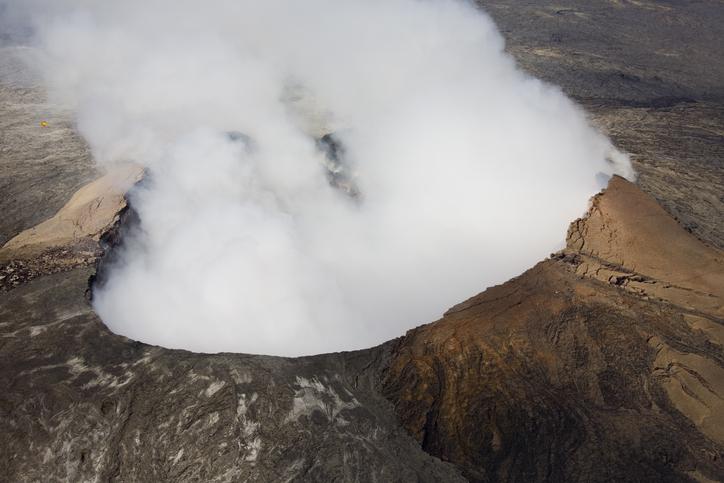 For decades, Park Rangers have kept the public safe inside the Kilauea active volcano zone inside of Volcanoes National Park. Rangers and scientists would monitor the activity of the youngest and most powerful volcano in Hawaii. Their efforts would allow visitors to get up close and personal with pools of molten lava.
For decades, Park Rangers have kept the public safe inside the Kilauea active volcano zone inside of Volcanoes National Park. Rangers and scientists would monitor the activity of the youngest and most powerful volcano in Hawaii. Their efforts would allow visitors to get up close and personal with pools of molten lava.
Halema’uma’u Crater, inside of Volcanoes National Park, was perceptually filled with a lake of lava. You were allowed to watch the bubbling molten rock from a safe distance at a viewing center, and the center even opened its doors after dark to give you a spectacular glowing show.
Flows of lava were commonly seen pouring out of Puʻu ʻŌʻō crater inside the park, as well. These two craters were the most reliable viewpoints for flowing lava in all of Hawaii. Unfortunately, in May of 2018, eruptions changed the landscape of the park and drained the craters. Currently, there is no more lava flowing in Volcanoes National Park.
But Park Rangers and other officials remain optimistic because this isn’t the first time that the craters have drained. A similar eruption completely drained Halema’uma’u Crater back in 1929, and the lava returned a short period later.
Keep up to date with this website to get more information about the flows of lava inside Volcanoes National Park. But, even if there is no lava flowing inside the park, the Volcano is a great place to visit. It contains massive volcanic craters that are now stable, so you can hike down inside of them. Essentially, you’ll be walking around the very top of a long-dead volcano. And the trails all have interesting names, like “Devastation Trail.” It’s a great way to see the fresh earthen scars left by the power of mother nature.
The visitors center is also a great place to learn about volcanic activity on the islands. You’ll learn a lot, and you can always ask the Park Rangers inside about the flow of lava on the island. Kilauea has stopped its activity inside the park, but it hasn’t stopped activity altogether. That means lava is flowing somewhere on the island, and the Park Rangers will have all that information on hand. And if you’re lucky, you can hike up to the new lava flow.
Kilauea Lava Flow
 Kilauea is the largest, youngest and most powerful volcano in the state of Hawaii. It no longer flows lava through Volcanoes National Park, but its lava flow can be found somewhere on the Big Island.
Kilauea is the largest, youngest and most powerful volcano in the state of Hawaii. It no longer flows lava through Volcanoes National Park, but its lava flow can be found somewhere on the Big Island.
You can see that lava flow in one of three ways. First, you can find the flow yourself and hike up to it. Secondly, you can hire a tour guide to be taken to the lava flow. Or, thirdly, you can jump on a boat that takes you up to the lava flow as it pours into the ocean somewhere on the southeast coast.
Seeing Kilauea’s Flows Yourself
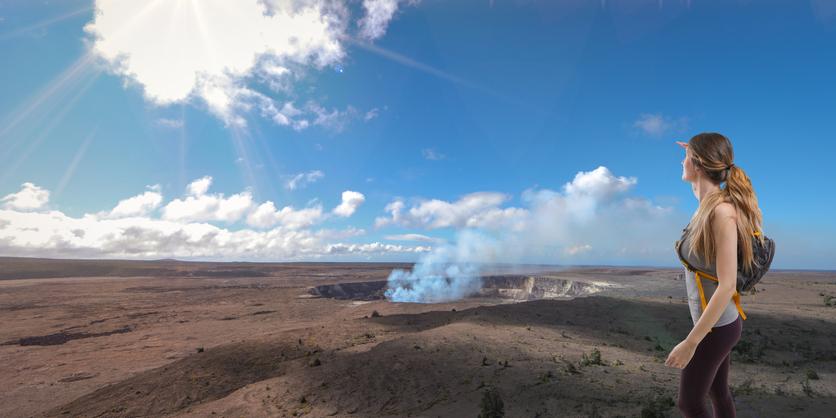 Recent eruptions and current flow levels will dictate where you’ll be able to see flowing lava from Kilauea, but, if you’re unlucky, lava viewing may not be possible at all. Information about the flows can change on a daily basis, but you’re most likely to see lava flowing into the ocean on the southeastern side of the island. It’s a place called the Lower East Rift Zone.
Recent eruptions and current flow levels will dictate where you’ll be able to see flowing lava from Kilauea, but, if you’re unlucky, lava viewing may not be possible at all. Information about the flows can change on a daily basis, but you’re most likely to see lava flowing into the ocean on the southeastern side of the island. It’s a place called the Lower East Rift Zone.
The Lower East Rift Zone is a vast field of sharp volcanic rock. There’s a road carved into this volcanic rock that takes you past some houses built into the inhospitable area. Some of the houses have been destroyed, but the entirety of the road is not open to the public. You’ll have to park your car and continue on foot, but you can usually find a vendor renting off-road bikes.
From here, you’ll have to hump yourself down to the lava flow. It’s black as far as the eye can see, and the tropical sun reflects heavily off the glassy rock, so make sure to pack sunscreen, a hat and plenty of water. But, sooner or later, your hard work will pay off. You’ll run into the flow of lava as it makes its way down to the ocean.
If you’re lucky, the lava flow will be like a river on the surface, but most of the time the lava flows underneath the surface. You’ll only be able to see it through cracks in the surface rock. But don’t worry about walking over the lava flow. The volcanic rock field is cordoned off to keep visitors safe.
You’ll also have to be very careful near the ocean. The lava creates a hissing cloud of steam and glass that is toxic to inhale. Again, state officials are very good at regulating foot traffic around the lava, but you should still be careful to keep your distance from the plume.
State officials are working hard to create a more permanent lava viewing platform after the most recent eruption changed the Big Island’s landscape. Stay tuned to this site for more information about Kilauea lava viewing as it becomes available.
Kilauea Tour Guide
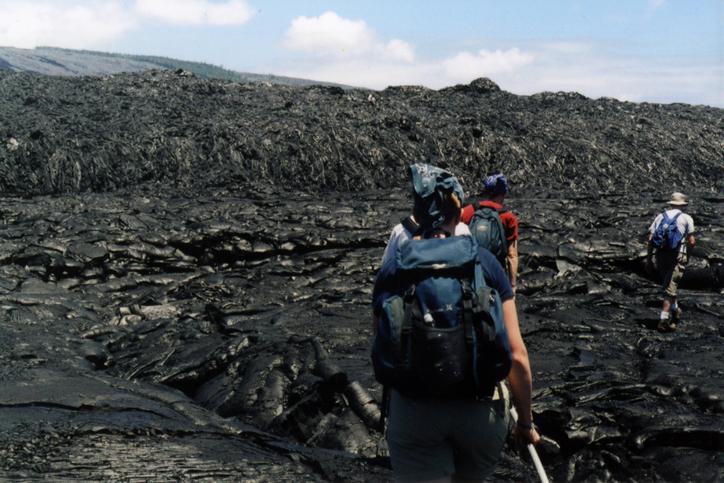 You can save yourself some time by joining a tour of the lava flow. Local experts run hikes and bike rides to the most recent and exposed lava flow on the island. Joining a crew means that hiking will be safer, and it will save you a lot of planning time.
You can save yourself some time by joining a tour of the lava flow. Local experts run hikes and bike rides to the most recent and exposed lava flow on the island. Joining a crew means that hiking will be safer, and it will save you a lot of planning time.
After all, the flows are constantly changing. So, no matter how well you plan ahead of time, you’ll have to do research the day you want to go see the lava. Relying on an expert will save you that research time, and time is the most valuable resource you have on the Hawaiian islands.
An expert will also be able to take you right to the hot spot. Pun intended. You won’t have to go venturing off into a volcano field on foot to find it yourself. So, a guide can save you time and effort. And it’s really hot out there on the black rocks.
Kilauea By Boat
 One of the most exciting ways to see Kilauea’s flow is by taking a boat. An experienced tour guide will take you and dozens of other tourists up close to the pour point; the area where lava flows of the Big Island into the Pacific Ocean.
One of the most exciting ways to see Kilauea’s flow is by taking a boat. An experienced tour guide will take you and dozens of other tourists up close to the pour point; the area where lava flows of the Big Island into the Pacific Ocean.
You don’t have to worry about getting too close or inhaling the toxic fumes because you are under the guidance of an experienced tour guide. That means you’ll get as close as humanly possible to the lava itself which makes for a stunning social media pic. A boat also takes all the guesswork and effort out of the equation. You just sit back and enjoy the destructive yet life-giving molten rock.
Hawaii’s Five Other Active Volcanoes
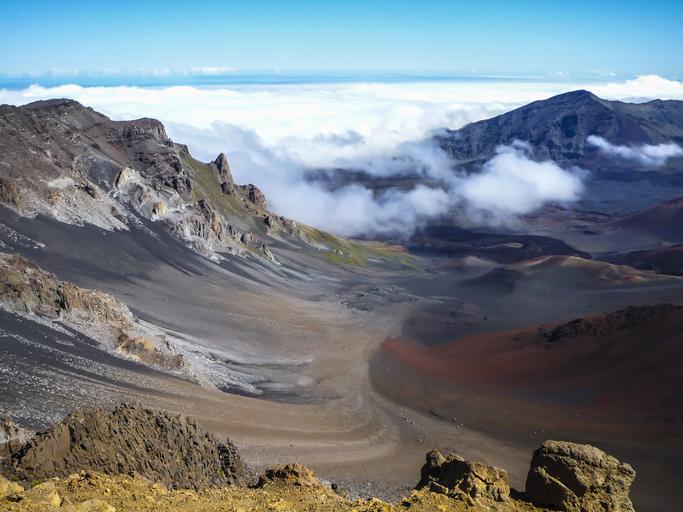 The Pacific Plate, one of many tectonic plates on planet earth, is constantly and slowly moving underneath the Hawaiian islands. But the plate is moving over a hot spot of magma underneath the islands, and this hot spot melts its way through the plate. When the buildup of lava gets too intense, it pours out of the ocean to harden into an island.
The Pacific Plate, one of many tectonic plates on planet earth, is constantly and slowly moving underneath the Hawaiian islands. But the plate is moving over a hot spot of magma underneath the islands, and this hot spot melts its way through the plate. When the buildup of lava gets too intense, it pours out of the ocean to harden into an island.
All of the Hawaiian islands have been formed by this activity, but most of the island’s volcanoes have become dormant. There is no volcanic activity on Kauai, Oahu, Molokai or Lanai. That means these islands, like many before them, are now eroding into the ocean. And, one day, they will perish altogether.
Hawaii’s four other active volcanoes are all on the Big Island. It’s fitting as the Big Island continues to grow by 40 acres per year, and a visit to Hawaii will illustrate the youth of the island. Nearly the entire western side of the island is a lava rock field where vegetation is yet to grow, and many of the island’s beaches are black sand. That means the lava rock has been pummeled by the ocean into sharp little pieces, but the beach has not yet had time to accumulate soft white sand.
The Big Island’s volcanoes include Mauna Kea, Mauna Loa, Hualalai, and Loihi. The massive mountains that mark the Big Island are still active volcanoes, though the activity is fairly rare. Mauna Loa last erupted in 1984, and the eruption lasted for 22 days. Mauna Kea has erupted about every six years and is the largest volcano on earth. Predicting lava flow from these 13,000-foot peaks is near impossible, so planning a visit around their eruptions would have to be last-minute.
Hualalai is to Mauna Loa’s northwest. It’s technically still active, but its slopes have been covered by Mauna Loa’s eruptions over the centuries, and it last erupted in 1801. And lonely Loihi can be found just south of Kilauea. Unfortunately, the volcano is completely underwater.
Haleakala National Park
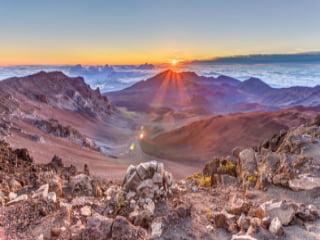 Zoom out on a map of Maui. You’ll see that the island is actually two islands that are fused together. The larger eastern island is where you’ll find the massive Haleakala Volcano with its crowning national park.
Zoom out on a map of Maui. You’ll see that the island is actually two islands that are fused together. The larger eastern island is where you’ll find the massive Haleakala Volcano with its crowning national park.
The crater at the top of the mountain is absolutely gorgeous, and it’s still technically active as a volcano. But don’t worry about an eruption. The last one took place between 1480 and 1600.
Haleakala is not a reliable place to catch a glimpse of molten rock, but it is a stunningly beautiful place nonetheless. The sleepy crater is a moonscape of colorful volcanic rock where oranges, purples, and reds glow at sunset or sunrise. And, during your visit, you walk around inside what is still technically an active volcano which is quite a brag-worthy experience.
As an added bonus, you can join a tour up to the crater. After enjoying the otherworldly landscape, you’ll be put on a bike to cruise down the long, slow slopes of the mountain back to town. It’s a refreshing, beautiful and exhilarating experience.
Can You Visit During An Eruption?
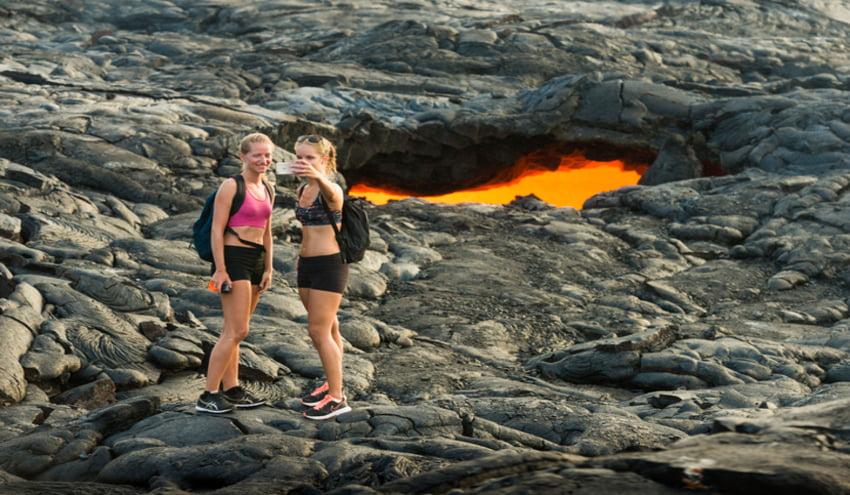 Yes, most of the time, you can visit Big Island during an eruption. The Big Island’s two main airports -- Hilo and Kona -- are a safe distance away from much of the volcanic activity. And you can usually continue to enjoy The Big Island even when an active eruption is taking place, depending on the size of the eruption, of course.
Yes, most of the time, you can visit Big Island during an eruption. The Big Island’s two main airports -- Hilo and Kona -- are a safe distance away from much of the volcanic activity. And you can usually continue to enjoy The Big Island even when an active eruption is taking place, depending on the size of the eruption, of course.
The main hazards during an eruption are the newly formed lava flows, which can tear through small towns, and air pollution. The air pollution is called volcanic fog, or “vog.” This vog can significantly affect the air quality on all of the Hawaiian islands.
Vog has a very peculiar look. It appears to be smog, but it carries a distinctive red hue. This shade of red can make the sun appear to be red, as well. And, of course, it carries a burned smell on the humid air.
Vog will carry downwind from the eruption, and the Big Island has distinctive east to northeast wind patterns. So the foggiest areas on the island will be to the south or southwest of the eruption site.
This air pollution can make it difficult or impossible for planes to land or take off from The Big Island if the eruption is large enough. Although, these vog groundings are rare. Kilauea’s last eruption, in May of 2018, put airlines on “red alert” but did not disrupt air traffic. You have to look all the way back to 2010 when a volcano erupted in Iceland which grounded planes throughout Europe for two weeks to see the last time vog affected air traffic.
However, the air pollution caused by volcanic eruption can cause some health problems. Older adults, young children, expectant mothers, people with asthma and cardiovascular disease are cautioned to stay away from voggy areas. The vog can increase your chances of respiratory ailments while causing a scratchy throat, eye, nose and skin irritation, coughing, phlegm, chest tightness, shortness of breath, fatigue, and dizziness.
But the Big Island is big. You’ll be able to avoid the affected areas quite easily while enjoying some clean air. The eruption will just make some of the island off-limits during your stay.